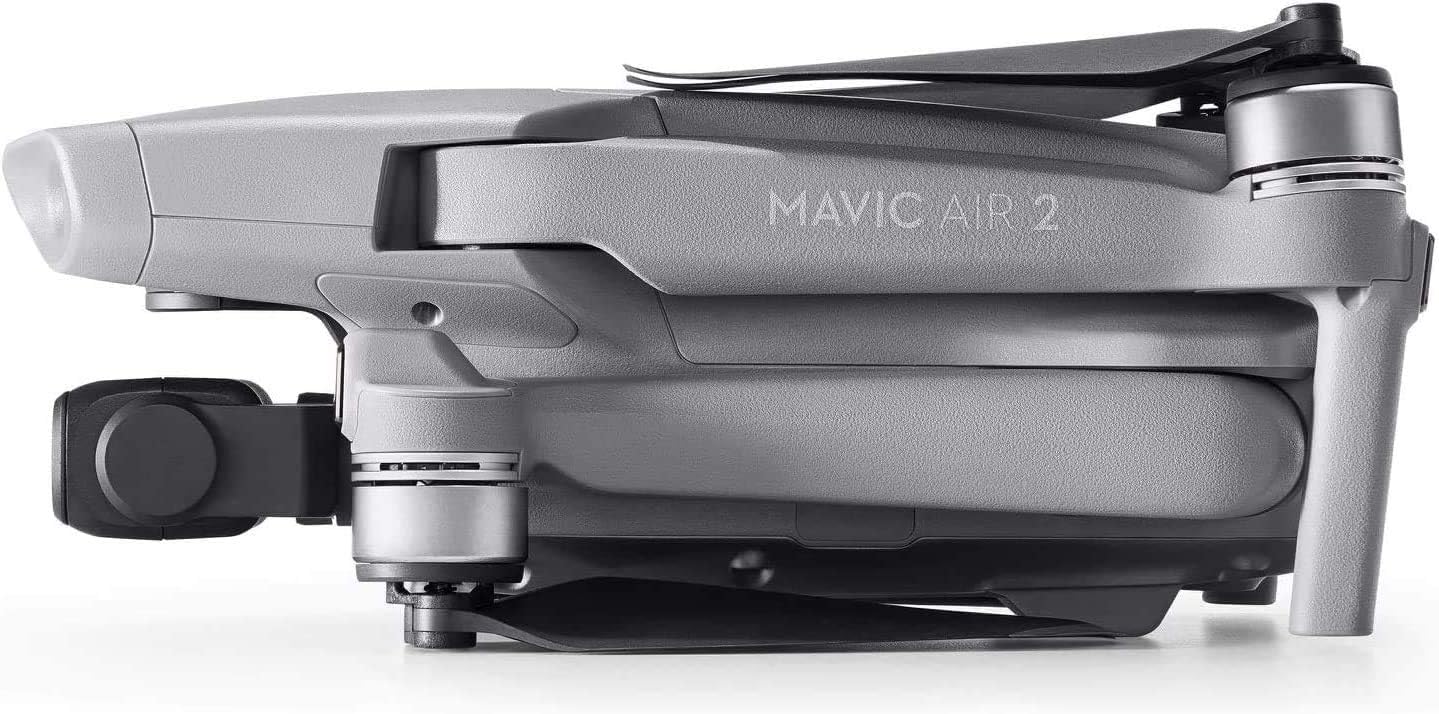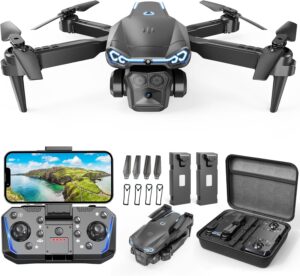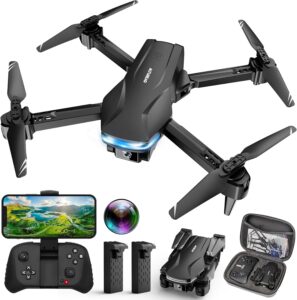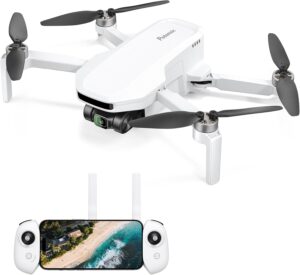Can we write this in David Sedaris’s exact style? We’re sorry—we can’t. But we’ll keep the voice witty, self-aware, and gently humorous throughout.
Why This Drone Caught Our Attention
We’ve always wanted to be the person at a family picnic who quietly launches a tiny quadcopter and makes the rest of us look like extras in a sweeping nature documentary. The DJI Mavic Air 2 felt like our chance to finally be that person without turning the picnic table into a tangle of cables, manuals, and crushed expectations.
The appeal here is simple: power without the bulk, intelligence without the intimidation, and a bundle that makes sense for real use—case, 128GB SD card, landing pad, and practical accessories. We wanted something that shoots 48MP photos, grabs 4K/60fps footage, and makes us look more skilled than we actually are. On paper, the Mavic Air 2 promises exactly that: a 1/2-inch Quad Bayer sensor, a 3-axis gimbal, OcuSync 2.0 transmission up to 10 km, up to 34 minutes of flight time, and smart tracking modes we can use without needing a pilot’s license from a parallel universe.
DJI Mavic Air 2 - Drone Quadcopter UAV with 48MP Camera, Case, 128gb SD Card, Landing pad Kit with Must Have Accessories
Unboxing and First Impressions
We popped open the case and felt that familiar sense of calm that arrives when gear looks clean, organized, and travel-ready. The drone itself is compact but substantial—light enough to bring on a day hike, solid enough to feel trusted in the wind. The controller is chunky in the best way, with a slide-out phone clamp that makes us feel like we’re preparing an action scene even if we’re really just filming our dog’s surprise sprint around the yard.
The landing pad may not sound exciting, but it solves a problem we didn’t know we had: preventing dusty takeoffs and awkward landings on gravel, tall grass, or the suspicious surfaces we’ve convinced ourselves are “probably fine.” Add the 128GB SD card and we’re not juggling files mid-flight. The whole package seems to say, “You’ll leave the house without me exactly once.”
Setup in Minutes: What We Learned
The DJI Fly app made activation and firmware updates straightforward, which we appreciated because the alternative is pretending we enjoy reading PDFs. We charged the battery, slid the 128GB card into the microSD slot, and removed the gimbal protector—a piece that looks like it should stay but absolutely should not. We’ve learned that lesson before, the hard way.
A quick calibration later and we were off to our first cautious flight. We started in a wind-free area and kept to a conservative altitude while we got used to the controls. The sticks are responsive and predictable, and gaining confidence came swiftly. We’re not saying we performed aerobatics, but we did stop whispering, “Please don’t hit anything” halfway through the second battery.
Camera Performance: Photos That Make Us Look Better Than We Are
The 48MP photo mode is the show-off friend who brings overflowing platters to a potluck. It’s based on a 1/2-inch Quad Bayer sensor that defaults to well-binned 12MP images with great dynamic range and less noise, but when we want to render every leaf on a maple tree with theatrical intensity, the 48MP option is there to indulge us.
HDR photos are strong, with nuanced skies and shadow recovery that stop short of cartoonish. SmartPhoto—DJI’s scene recognition—steers JPEGs toward balanced, pleasing results with minimal fuss. We found that for social media and quick shares, SmartPhoto JPEGs are more than enough. For edits and prints, we switched to RAW (DNG) and had plenty of flexibility to push highlights, lift shadows, and fine-tune white balance without the image disintegrating like a sandcastle at high tide.
Low light is respectable for a drone of this size. We’re not ordering a candlelit sky replacement package, but sunset and blue-hour photos came out surprisingly clean with careful exposure and the right shutter speed. If we want cinema-grade night footage, we’d look at a larger-sensor model, but for most real-world twilight shots, the Mavic Air 2 makes us feel like we planned it all along.
Video Quality: 4K/60fps Smoothness Without the Drama
There’s a reason 4K/60fps is the new benchmark for drone filmmaking. The Mavic Air 2 handles it with assurance, giving us crisp detail and natural motion that makes sweeping pans and slow passes incredibly satisfying. We found color straight out of the camera to be pleasing and not overcooked, which gives us latitude to grade later or just leave it as-is when speed matters.
HDR video is available thanks to the Quad Bayer design, and it’s particularly good for high-contrast situations where regular profiles clip too early. If we’re shooting a beach with bright sun and reflective water, HDR helps keep that balancing act under control. For slow motion antics, 1080p up to 240 fps turns a leaping dog into a mini nature special, which is precisely the kind of indulgence we live for.
Stabilization and Gimbal: The Unbothered Butler
The 3-axis mechanical gimbal feels like the unbothered butler of the operation, smoothing our amateur stick work into something far more polished. Even in moderate wind, horizon level stayed true. The difference between flying and filming is the difference between “We tried” and “We’ve got a shot.” The Mavic Air 2’s gimbal made sure we had the latter.
OcuSync 2.0 Transmission: The Calm in the Signal Storm
OcuSync 2.0 impressed us immediately. Up to 10 km of rated transmission range may not be something we try casually, but what it means in practical terms is an exceptionally stable, low-latency 1080p live view. We flew in suburban areas dotted with Wi-Fi, power lines, and nervous squirrels, and the video feed stayed rock-solid. For framing, that confidence means we can compose rather than guess.
We also appreciated the automatic frequency switching. The system hops between 2.4 GHz and 5.8 GHz as needed, which, in the world of invisible interference, feels like having an aviation-savvy therapist: calm, sensible, and adjusted on the fly.
Flight Performance and Safety
On paper, up to 34 minutes of flight time sounds like forever. In practice, with wind and our habit of interrupting shots to announce how beautiful they are, we saw an honest 22–28 minutes per battery. Still generous. We learned to resist the urge to lift off at 65% battery “for just one more quick shot” unless we wanted our hearts to do cardio.
Mavic Air 2 senses obstacles in three directions—forward, backward, and downward—which is exactly where our accidents used to happen. The downward sensors also assist with smooth landings and hovering accuracy. There’s Return-to-Home, of course, which we tested more than once, partly because we wanted to and partly because we panicked and tapped it like it was a hotel elevator button.
Some models include ADS-B AirSense to detect nearby aircraft and alert us in the app. It’s region-dependent, so we treat it as a useful bonus rather than a promise. Either way, we make a habit of keeping line of sight and being aware of our surroundings because the goal is lifelong hobby enjoyment, not a dramatic headline.
Intelligent Modes: Spotlight 2.0, ActiveTrack 3.0, and POI 3.0
Spotlight 2.0 is our favorite for subject-driven shots. We choose a subject, lock the camera on them, and fly freely without losing framing. It gives us operator confidence we couldn’t fake on our own—great for bikes, runners, or a person walking through a landscape we want to show off.
ActiveTrack 3.0 is more autonomous, following a moving subject while trying to keep them in frame. We had the best luck with moderate speeds and clear surroundings, where the tracking looked purposeful rather than frantic. And POI 3.0 is the “make it cinematic” button: set a point of interest and let the drone orbit elegantly, adjusting speed and radius to taste. It’s our go-to for establishing shots that whispers, “We thought about this.”
QuickShots and Hyperlapse: Set, Go, Bask
QuickShots are the pre-programmed maneuvers that make us look slick with minimal effort: Dronie, Rocket, Circle, Helix, Boomerang, Asteroid. We used them far more than we expected because they’re reliable and genuinely fun. It’s a great way to get share-ready clips in minutes.
Hyperlapse is another gem. We can set a route with Waypoints or choose Free, Circle, or Course Lock, and the drone captures stabilized frames at intervals. The Mavic Air 2 supports 8K Hyperlapse in select modes, which looks incredible over cityscapes and coastlines. These are the kind of shots that make relatives ask if we’ve changed careers.
Accessories in This Bundle: Why They Matter
This bundle earns its “must have” badge by checking off problems we otherwise solve one purchase at a time. The included case keeps the drone, controller, and bits from rattling around in a backpack like a bag of marbles. The 128GB SD card means we’re ready to shoot a full day without managing space mid-flight. And the landing pad means our rotors aren’t chewing dirt and our gimbal isn’t inhaling tiny rocks at takeoff.
If we’re practical, this is exactly how we want to start: ready to fly the day it arrives, with the core accessories we would have bought anyway.
Battery Life and Charging Strategy
We learned to think in terms of “missions,” not “flights.” Each mission gets a mental checklist and a battery plan. We aim to land with no less than 20–25% remaining. That gives us a cushion for wind, curiosity, and “just one more pass.” Charging is straightforward, and the batteries hold charge well. If we’re taking a road trip or a long hike, we plan stacks of flights: Battery 1 for scouting, Battery 2 for the main sequence, Battery 3 for alternates and safety.
A note on care: we don’t store batteries fully charged or fully depleted. Somewhere in the middle keeps them happier longer, and we like happy batteries. They return the favor with dependable performance when it counts.
Image Workflow and Codecs
Our photo workflow usually starts with RAW (DNG) when we care about the final look, and JPEG when we’re collecting quick wins. Lightroom or our editor of choice handles the DNGs easily. For video, we like to shoot in a flatter profile and grade later, but the standard profile can be perfectly fine for same-day edits.
The Mavic Air 2 records clean 4K up to 60 fps and uses efficient compression that balances quality and file size well. The included 128GB card is a practical match—we’ve stretched a full day of mixed clips on one card with room to spare, especially if we’re disciplined about deleting the outtakes where we forgot to stop recording.
Who This Drone Suits Best
- Travelers and hikers who want a capable but compact drone that doesn’t dominate the bag.
- Content creators who need reliable 4K/60 and strong 48MP stills without the price or heft of larger rigs.
- Beginners who want obstacle sensing, smart modes, and a smooth app experience.
- Real estate shooters who need clean, stable video and high-res stills at a sensible cost.
- Families who want to make memory videos that actually look cinematic, not just optimistic.
If we’re strictly focused on low-light filmmaking or pro-level bitrates and color depth, a larger-sensor option is better. If we need the smallest possible drone to skip registration in some regions, the sub-250g crowd is appealing. But for an all-rounder that feels grown-up without being fussy, this hits a delightful middle.
Key Specs and Bundle Highlights at a Glance
| Feature | What We Get | Why It Matters |
|---|---|---|
| Sensor | 1/2-inch Quad Bayer CMOS | Strong detail, 48MP photos, flexible HDR |
| Photo Resolution | Up to 48MP | Large, crisp stills with room to crop |
| Video | Up to 4K/60fps | Smooth motion, sharp detail for modern workflows |
| Stabilization | 3-axis gimbal | Silky footage, steady framing |
| Transmission | OcuSync 2.0, up to 10 km | Stable 1080p live view, low latency |
| Flight Time | Up to 34 minutes | Fewer landings, more creative time |
| Obstacle Sensing | Forward, backward, downward | Safer flights, easier learning curve |
| Intelligent Modes | Spotlight 2.0, ActiveTrack 3.0, POI 3.0 | Subject locking, autonomous tracking, cinematic orbits |
| QuickShots/Hyperlapse | Multiple preset maneuvers, 8K Hyperlapse in select modes | Fast, shareable, stylish shots |
| Included Extras | Case, 128GB SD card, landing pad, accessories | Ready to fly, protected gear, longer shoots |
Real-World Shooting: Moments That Sold Us
We took the Mavic Air 2 to a lakeside trail at golden hour and tried not to narrate everything like a retirement plan commercial. With the sun easing down and water rippling toward shore, 4K/60 gave us exactly the warmth and crispness we wanted. We set a POI orbit around a lone kayaker who seemed touched by something we couldn’t name—probably just the need to turn off their phone. The results were smooth, stable, and downright pretty.
On another day, we stood in a field while a friend sprinted down a dirt path with a late-afternoon shadow chasing him. ActiveTrack kept him centered well enough that we only ruined two takes by hollering, “This looks fantastic!” That third take? Undeniably usable.
Pros and Cons We Actually Feel
- Pros:
- Excellent image quality for the size and price—48MP photos and 4K/60fps make a persuasive pair.
- OcuSync 2.0 is the transmission system we want in most environments: stable and reassuring.
- Intelligent modes we actually use, not just admire from afar.
- Long flight time in practice; we get the shots we want without scheduling a landing every eight minutes.
- The bundle saves us from accessory purgatory: case, big SD card, and a landing pad we didn’t know we’d love.
- Cons:
- No lateral obstacle sensors; careful side-to-side moves are on us.
- Low-light video is good for the size, but not the realm of larger-sensor drones.
- The controller is comfortable but not small; it will demand pocket space it hasn’t earned yet.
- Geofencing and firmware updates are a fact of life; we plan a few extra minutes before a shoot.
Tips for Safer, Smoother Flights
- Start low and slow. Give yourself space to learn the feel of the sticks, how the drone reacts, and the app’s layout.
- Use the landing pad, especially on gravel, sand, or tall grass. Your gimbal will thank you with years of service.
- Keep props fresh. If we clip a twig or see nicks, we replace blades rather than try to reason with aerodynamics.
- Calibrate when the app suggests it. A quick compass or IMU calibration is easier than chasing a mystery wobble.
- Treat the 20–25% battery mark as “start returning” time. The shot we miss isn’t worth the landing we bungle.
- Check local rules. We like flying more than arguing, so we stay legal, courteous, and boring in all the right ways.
- Use ND filters if motion blur matters. For cinematic shutter speeds in bright sun, ND filters are our calm in the glare.
The Learning Curve: Short and Painless
We’ve flown twitchy drones that made us question whether we actually wanted this hobby. The Mavic Air 2 is not that. The DJI Fly app is clear, the flight characteristics are predictable, and the intelligent features reduce cognitive load in ways we didn’t realize we needed. Spotlight felt like putting training wheels on a shot and discovering we like training wheels.
We also appreciated how much thought went into small things, like the phone clamp, the cable routing, and the way the app gently insists on preflight checks. It nudged us toward the right habits until they were ours.
Little Things That Make a Big Difference
- The gimbal protector clicks on and off with a satisfying certainty. That certainty is the difference between a pristine lens and sandpaper.
- The case is designed for actual humans. Zippers, compartments, everything where we reach for it.
- Firmware updates feel less like chores and more like, “Here’s your new toy’s improvement pill.” We do them when we have coffee, not when we have a crowd watching.
- The 128GB card means our flights aren’t interrupted by the mid-sentence drama of “card full.” We keep a spare anyway, because that’s who we are now.
Comparison Notes: Mavic Air 2 vs Siblings and Neighbors
- Versus DJI Air 2S: The Air 2S has a larger 1-inch sensor and 5.4K video, making it stronger in low light and high dynamic range scenes. If ultimate image quality matters most, the Air 2S is a step up. If we want excellent quality for less and value longer flight time per cost, the Mavic Air 2 remains compelling.
- Versus DJI Mini-class drones: The Ultra-light Minis are easier to carry and sometimes skate under registration thresholds in certain regions. But the Mavic Air 2 wins on obstacle sensing coverage, transmission strength, top-end video specs, and wind resistance. If we’re shooting in more demanding conditions, the Air 2’s confidence matters.
- Versus larger pro drones: Bigger rigs bring better sensors, bitrates, and lenses, but they also bring more weight, more attention, and more cost. For 90% of what we want to film for social, YouTube, or clients with reasonable expectations, the Mavic Air 2 is enough. For the other 10%, we rent.
Reliability and Maintenance
We fly often, and the Mavic Air 2 gives us consistent results when we treat it well. We keep the firmware current, inspect props, wipe the lens, and use the landing pad. We also carry microfiber cloths like we’re part of a club with low entry fees and strict standards.
We haven’t babied it. It’s endured backpacks, car trunks, and the occasional “We forgot you in the sun for three minutes” moment with grace. We’ve learned that drones reward routine. The more we keep to a rhythm—charge, check, calibrate—the more the drone becomes something we can trust instead of something we’re babysitting.
Editing and Sharing: From Flight to Finished
We aim for a simple pipeline: import, cull, color, export. The footage from the Mavic Air 2 drops neatly into our existing projects with mirrorless cameras. We match color profiles by eye or with lightweight LUTs and move on. If we’re cutting a reel for social media, the 4K resolution gives us headroom to crop for vertical without turning our footage into a mosaic.
For stills, the 48MP files are spacious. We can crop generously and still land at high-quality exports. We’ve printed a few, and they hold up well when we pick up the print and stand too close, the way we do with every print, as if we’re a suspicious art critic in a quiet room.
A Few Quirks to Keep in Mind
- Sideways movement demands our attention. With obstacle sensors not covering lateral motion, we double-check our surroundings before strafing.
- The controller’s size is comfortable in hand but a bit proud in a jacket pocket. Worth it for the sturdiness and antenna performance.
- Strong wind is manageable, but we don’t tempt fate near water or cliffs when gusts pick up. Our footage looks best when our guts aren’t clenched.
- We keep a checklist card. It’s not fancy: batteries charged, props inspected, gimbal protector off, SD card in, home point confirmed, RTH altitude set. The number of problems this prevents is astonishing.
Use Cases That Shine
- Real estate walk-arounds with clean orbits and gentle ascents that make even normal houses feel aspirational.
- Landscape establishing shots for travel videos—moving from mid-tree height to a horizon reveal that makes our cousins text, “What did you film that with?”
- Event coverage from a respectful distance, capturing the setting and scale without trying to be the event.
- Solo creators who want smart tracking to hold a subject while they bike, run, or hike through a scene.
- Family movies where the drone becomes a memory machine rather than a spectacle. Kids and pets look surprisingly heroic from above.
Price-to-Performance: Where It Lands
We evaluate gear by how often we reach for it. The Mavic Air 2 keeps getting the nod because it threads the needle between capability and convenience. We don’t bargain with ourselves about whether today is “worth it”; we just bring it. The quality stacks up well in mixed projects and the flight time, transmission, and safety features make repeatable results the norm.
For many of us, it’s the “first serious drone” that doesn’t feel like a compromise. It’s also the veteran’s “second body” that travels easier and still hits professional marks in the right hands.
What We’d Add Down the Road
- A second or third battery to extend sessions without changing our creative plan to fit a charging schedule.
- ND filter set for proper shutter control in bright daylight when cinematic motion blur is the goal.
- A compact charging hub to wrangle batteries at home or on the road.
- Spare props because future-us is always grateful for past-us thinking ahead.
The Moments It Made Possible
We remember sunrise at a quiet overlook, powering up while the world yawned. We set a simple Course Lock and watched the light brush treetops with that brief, impossible glow. The footage is peaceful in a way we rarely are. On another day, we captured a long coastal shot where the foam on the water made filigree patterns we only saw later in edit. It felt like a gift—one we wouldn’t have received without the reach and steadiness of a small aerial camera that goes where we go.
The Bottom Line
The DJI Mavic Air 2, bundled with a case, 128GB SD card, landing pad, and essential accessories, is a confident, capable aerial camera that makes us better filmmakers and photographers with minimal drama. It records 4K at up to 60 fps, captures 48MP stills, flies up to 34 minutes under ideal conditions, and sends a stable 1080p live feed via OcuSync 2.0 that keeps our framing precise. With Spotlight 2.0, ActiveTrack 3.0, and POI 3.0, it helps us create shots we used to storyboard and then abandon.
We love it for the simplicity and the results. We reach for it because it works and because it’s polite about our learning curve. The bundle’s accessories reduce friction so that the moment we want to fly and film, we can. If we were to grade it for most creators and hobbyists, we’d land in the “this is the one we’d recommend first” category. It’s the drone that shows up, does the job, and then quietly waits for the next excuse to take off.
Verdict We Can Stand Behind
If our goal is to make crisp, cinematic footage and high-resolution photos without hauling a small aircraft, this checks the right boxes. It’s portable, powerful, and considerate, which is a combination we don’t see often enough in gadgets or people. We’ll keep it in our kit for the days when the sky is interesting, the light is flattering, and we’re ready to be the sort of storytellers who can say, “We got the shot,” and mean it.
Disclosure: As an Amazon Associate, I earn from qualifying purchases.







